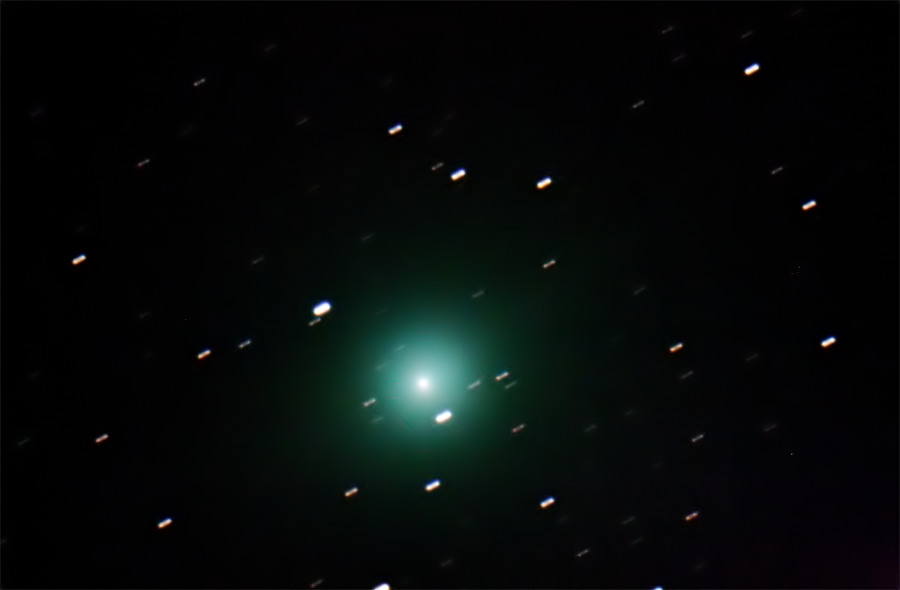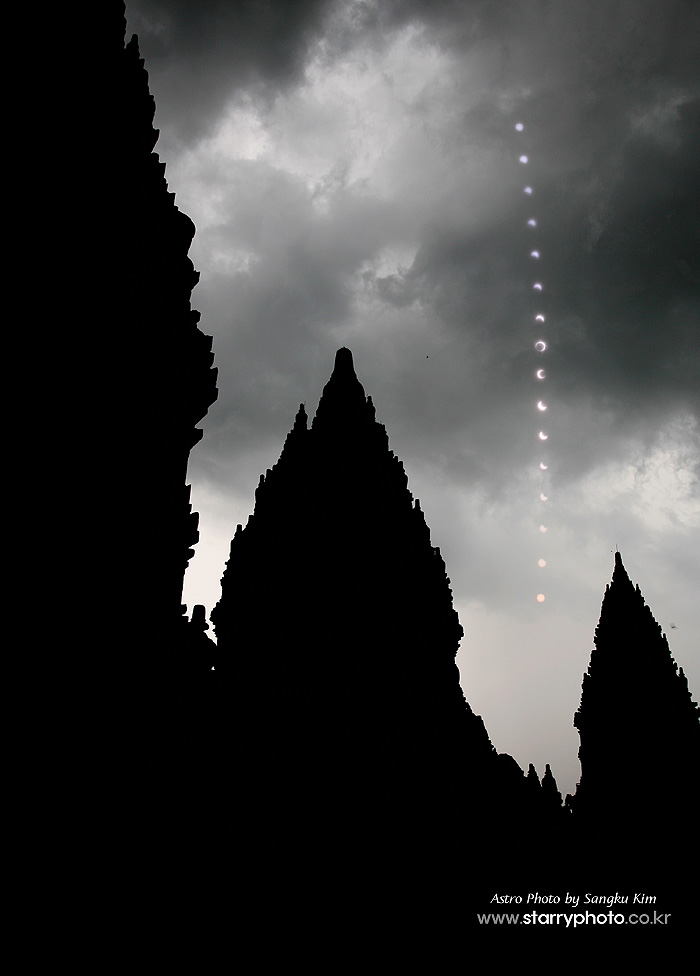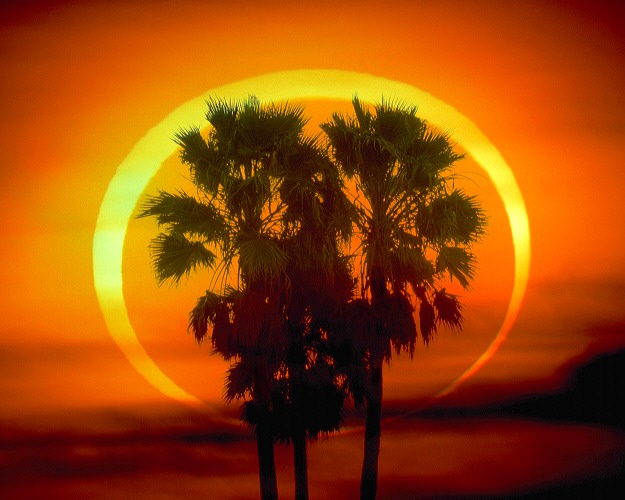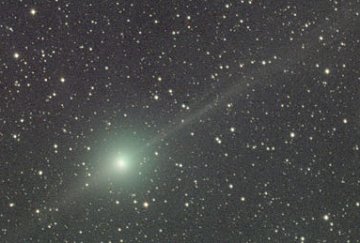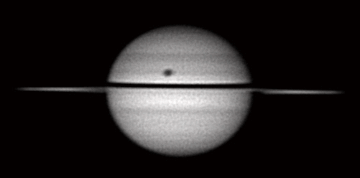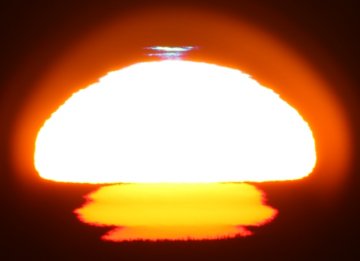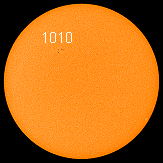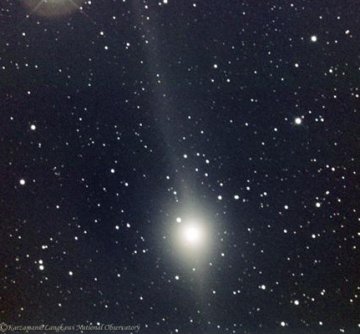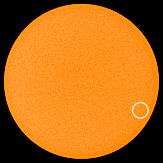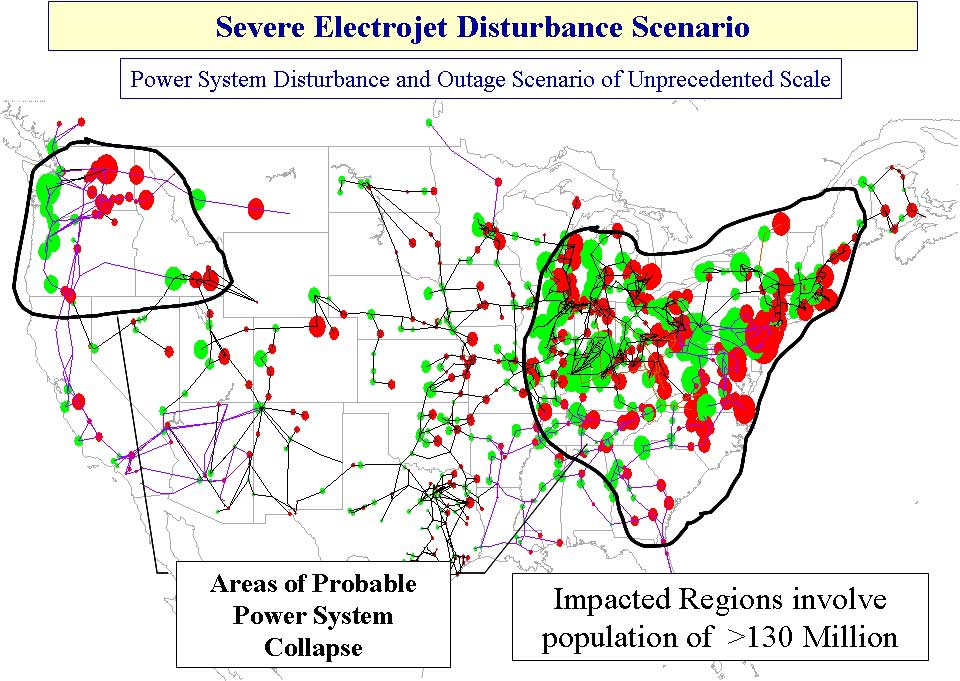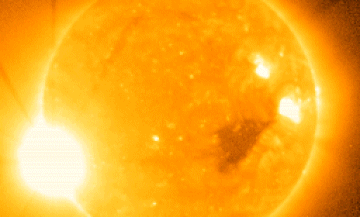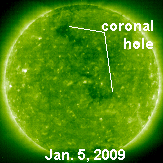|
1-31-09 - No sunspots today
Just hours ago, Mahdi Zamani used a Canon 30D to photograph the pair over Tehran, Iran: "The Moon and Venus looked very nice shining over Sanat square and the Milad tower," says Zamani. "Milad is the tallest tower in Iran and Sanad square is at the center of northwest Tehran."more images: from Wienie van der Oord in the eastern Negev desert, Israel; from Minghelli of L'Escarčne, Alpes Maritimes, France; from Patrick Jablonski of Normandie, France; from Eleazar Sánchez of Shanghai, China; from Mike O'Leary of El Cajon, California; from Larry Fischer of Topeka, Kansas; from Hal Schade of Rio Dulce, Guatemala; from Alfredo Garcia Jr of Torrance Beach, California; from Sam Cole of Austin, Texas; Current conditions Solar windspeed: 405.2 km/sec density: 4.9 protons/cm3 explanation | more data Updated: Today at 0113 UT X-ray Solar Flares 6-hr max: A0 2355 UT Jan30 24-hr: A0 1220 UT Jan30 explanation | more data Updated: Today at: 2355 UT
|
|||||||||||||||||||||||||||||||||||||||||
|
1-30-09 - No sunspots today
Current conditions
Solar wind speed: 399.1 km/sec density: 3.2 protons/cm3 explanation | more data Updated: Today at 2357 UT X-ray Solar Flares 6-hr max: A0 2350 UT Jan29 24-hr: A0 2350 UT Jan29 explanation | more data Updated: Today at: 2350 UT |
|||||||||||||||||||||||||||||||||||||||||
|
1-29-09 - There are no sunspots today
Solar wind speed: 398.1 km/sec density: 9.6 protons/cm3 explanation | more data Updated: Today at 0144 UT X-ray Solar Flares 6-hr max: A0 2355 UT Jan28 24-hr: A0 2355 UT Jan28 explanation | more data Updated: Today at: 2355 UT
|
|||||||||||||||||||||||||||||||||||||||||
|
1-28-09 - No sunspots today - Yesterday's
sunspot has faded away, leaving the sun blank. Credit: SOHO/MDICurrent
conditions
Solar wind speed: 401.9 km/sec density: 9.2 protons/cm3 explanation | more data Updated: Today at 2346 UT X-ray Solar Flares 6-hr max: A0 2340 UT Jan28 24-hr: A0 2340 UT Jan28 explanation | more data Updated: Today at: 2340 UT
|
|||||||||||||||||||||||||||||||||||||||||
|
1-27-09 A new sunspot is forming in the
circled region. The low latitude of the spot tentatively identifies it as a
member of old Solar Cycle 23. Credit: SOHO/MDICurrent
conditions
Solar wind speed: 395.7 km/sec density: 3.6 protons/cm3 explanation | more data Updated: Today at 2345 UT X-ray Solar Flares 6-hr max: A0 1940 UT Jan27 24-hr: A0 1030 UT Jan27 explanation | more data Updated: Today at: 2340 UT NAMIBIA FIREBALL: Last night, Jan. 27th, around 2105 local time in Namibia, sky watchers witnessed a slow, bright fireball that disintegrated into "thousands of lights, almost like fireworks," says Crone Bergh of Windhoek. Fragments of "various sizes [appeared to be on fire] and left white smoke trails in the air," adds J.C. Vorster, also of Windhoek. This was probably the expected reentry of a Russian Molniya-M rocket, which launched a military satellite in Dec. 2008. The ground track of the decaying rocket passed over Namibia in a direction that fits the description of the witnesses THE GREEN COMET COMETH: The first thing that strikes most observers when they see Comet Lulin is the color: It's green! Astrophotographer GĂĽnther Strauch recorded the hue on Jan. 26th from his backyard observatory in Borken, Germany:
Green is a sign of poisonous gas. The comet's atmosphere contains toxic cyanogen (CN) and diatomic carbon (C2). Both substances glow green when illuminated by sunlight via a process called "resonant fluorescence." In 1910, many people panicked when astronomers revealed Earth would pass through the cyanogen-rich tail of Comet Halley. False alarm: The wispy tail of the comet couldn't penetrate Earth's dense atmosphere; even it if had penetrated, there wasn't enough cyanogen to cause real trouble. Comet Lulin will cause even less trouble than Halley did. At closest approach on Feb. 24, 2009, Lulin will stop 38 million miles short of Earth, a distant fuzzball easily seen in binoculars, possibly visible to the unaided eye, utterly harmless.
Comet Lulin Photo Gallery More photos and info below
|
|||||||||||||||||||||||||||||||||||||||||
|
1-26-09 No sunspots today
Current conditions
Solar wind speed: 374.6 km/sec density: 16.1 protons/cm3 explanation | more data Updated: Today at 0404 UT X-ray Solar Flares 6-hr max: A0 2355 UT Jan25 24-hr: A0 2355 UT Jan25 explanation | more data Updated: Today at: 2355 UT ANIMATED ANNULAR ECLIPSE MAP - THIS IS REALLY COOL SOLAR ECLIPSE: The Year of the Ox is beginning with a solar eclipse. On Monday, Jan. 26th, the same new Moon that triggers the Chinese Lunar New Year will pass directly in front of the sun--dead center--covering 93% of the solar disk. The ensemble will form a stunning "ring of fire" visible across the Indian Ocean:an animated map of the eclipse prepared by graphic artist Larry Koehn. A regional map of Indonesia shows the best dry places to see the ring of fire: Borneo, Sumatra and Java. Outside the narrow path of annularity, the Moon will cross the sun off-center, producing crescent suns of varying depth over south Africa, Madagascar, Australia, southern parts of India and southeast Asia. Sky watchers in those places should attend to the ground: crescent sunbeams will dapple the earth beneath leafy trees and garden latticework. Solar telescopes trained on the sky will show the Moon taking a bite out of the sun. Stay tuned for photos!
On Monday, Jan. 26th, something did. The disk of the sun transformed into a ring: SOLAR ECLIPSE: The jagged spires of Candi Prambanan, an ancient Hindu temple in Java, never fail to make a deep impression on visitors. An atmosphere of celestial expectation swirls through the grounds as the architecture itself draws attention to the heavens. It feels like something amazing is about to happen. On Monday, Jan. 26th, something did. The disk of the sun transformed into a ring: "It was an annular solar eclipse," explains photographer Sangku Kim of Merak, Indonesia. The Moon passed in front of the sun--dead center--covering 93% of the solar disk. "I photographed the event at 10 minute intervals using my Canon 5D and a Baader solar filter." Similar rings of fire, crescent suns, and strangely-shaped shadows were witnessed along an "path of annularity" spanning the Indian Ocean from the waters off South Africa to the islands of Indonesia, Malaysia and the Philippines. Browse the gallery for the latest photos: UPDATED:
Jan. 26 Solar Eclipse Gallery See photos and information about annular eclipse under photo below:
|
|||||||||||||||||||||||||||||||||||||||||
|
1-25-09 Current conditions Solar windspeed: 284.6 km/sec density: 2.5 protons/cm3 explanation | more data Updated: Today at 0344 UT
6-hr max: A0 2355 UT Jan24 24-hr: A0 1315 UT Jan24 explanation | more data CURIOUS ASTEROID FLYBY: Newly-discovered asteroid 2009 BD is slowly passing by Earth today only 400,000 miles away. The approximately 10 meter-wide space rock poses no significant threat, but it merits attention anyway: The orbit of 2009 BD appears to be almost identical to the orbit of Earth. 2009 BD may be a rare "co-orbital asteroid," circling the sun in near-tandem with our planet. If current measurements of the asteroid's orbit are correct, 2009 BD will remain in Earth's neighborhood for many months and possibly years to come. Visit http://spaceweather.com to view the asteroid's curious orbit. |
|||||||||||||||||||||||||||||||||||||||||
|
1-24-09 - No sunspots todayCurrent
conditions
Solar wind speed: 276.5 km/sec density: 4.1 protons/cm3 explanation | more data Updated: Today at 2342 UT X-ray Solar Flares 6-hr max: A0 2340 UT Jan24 24-hr: A0 1315 UT Jan24 explanation | more data Updated: Today at: 2340 UT MASSPIKE FIREBALL: Last night a meteoroid of unknown size hit Earth's atmosphere over New England. Its bright, blue-green disintegration startled motorists driving along the Massachusetts Turnpike and surrounding areas: eye-witness accounts.
|
|||||||||||||||||||||||||||||||||||||||||
|
1-23-09 - No sunspots today
Current conditions
Solar wind speed: 312.9 km/sec density: 5.4 protons/cm3 explanation | more data Updated: Today at 0936 UT X-ray Solar Flares 6-hr max: A0 0935 UT Jan23 24-hr: A0 0935 UT Jan23 explanation | more data Updated: Today at: 0935 UT
Ring of Fire Eclipse - An Annular eclipse - moon in front of the sun - January, 1982 SOLAR ECLIPSE: Oh to be in Borneo! On Monday, Jan. 26th, inhabitants of that heavily forested island will witness the sunset of a lifetime. Just as the sun descends into the waves of the Indian Ocean, the Moon will pass in front of the sun--dead center--covering 93% of the solar disk. The ensemble will form a stunning "ring of fire," something like this: Similar sunset rings will appear over the nearby islands of Java and Sumatra: map. Astronomers call such an event an annular eclipse. The first solar eclipse of 2009 occurs January 26th. An annular eclipse will be visible from a wide track that traverses the Indian Ocean and western Indonesia. A partial eclipse will be seen within the much larger path of the Moon's umbra shadow, which includes the southern third of Africa, Madagascar, and Australia (except Tasmania), southeast India, Southeast Asia and Indonesia.
An annular eclipse occurs when the Moon covers the center of the Sun, but not its edges. This leaves a ring (or annulus) of the Sun visible around its edges. The Moon in its elliptical orbit is farther from the Earth, and the *umbra is too short to reach the Earth. However, the Moon is directly in front of the Sun, so parts of the Earth see a partial eclipse where the center of the Sun is covered. This leaves a ring -- an annulus -- of the Sun visible round the edges of the Moon.
*Umbra is the Latin word for 'shadow'. The umbra is the darkest part of a shadow. From within the umbra, the source of light is completely concealed by the occulting body. In astronomy, an observer in the umbra is said to be in the shadows experiencing total eclipse.
Elsewhere, the Moon will pass off-center producing crescent suns of varying depth over south Africa, Madagascar, Australia, southern parts of India and southeast Asia. Sky watchers in those places should attend to the ground: crescent sunbeams will dapple the earth beneath leafy trees and garden latticework. Stay tuned for photos! Related links:
|
|||||||||||||||||||||||||||||||||||||||||
|
1-22-09 - No sunspots todayCurrent
conditions
Solar wind speed: 404.4 km/sec density: 1.3 protons/cm3 explanation | more data Updated: Today at 2344 UT X-ray Solar Flares 6-hr max: A0 2340 UT Jan20 24-hr: A0 1030 UT Jan20 explanation | more data Updated: Today at: 2340 UT SOLAR ACTIVITY: There are no spots on the sun, but that doesn't mean solar activity is nil. A massive prominence is dancing along the sun's northeastern limb, putting on a lively show for backyard solar telescopes. Images: #1, #2.
|
|||||||||||||||||||||||||||||||||||||||||
|
1-21-09 - No sunspots today
Current conditions
Solar wind speed: 414.4 km/sec density: 4.6 protons/cm3 explanation | more data Updated: Today at 2245 UT X-ray Solar Flares 6-hr max: A0 2240 UT Jan21 24-hr: A0 2240 UT Jan21 explanation | more data Updated: Today at: 2240 UT COMET LULIN UPDATE: "Right now, Comet Lulin (C/2007 N3) is an easy target for binoculars and small telescopes," reports Mariano Ribas of Buenos Aires, Argentina. "It is visible despite our strong urban light pollution. I have been observing the comet during the hours before dawn and estimate its visual magnitude as +7. Maybe this will not be a 'great' comet like McNaught was two years ago, but I look forward to a good show in the weeks ahead as Comet Lulin approaches Earth." [gallery] [sky map] [finder chart]
|
|||||||||||||||||||||||||||||||||||||||||
|
1-20-09 - No sunspots today - sunspot 1011 has already disappeared
Solar wind speed: 404.4 km/sec density: 1.3 protons/cm3 explanation | more data Updated: Today at 2344 UT X-ray Solar Flares 6-hr max: A0 2340 UT Jan20 24-hr: A0 1030 UT Jan20 explanation | more data Updated: Today at: 2340 UT
|
|||||||||||||||||||||||||||||||||||||||||
|
1-19-09 - a sunspot appeared today in the center of the sun - low down - This
is # 1011 A new sunspot is emerging inside
the circle region--and it is a strange one. The low latitude of the spot
suggests it is a member of old Solar Cycle 23, yet the magnetic polarity of the
spot is ambiguous, identifying it with neither old Solar Cycle 23 nor new Solar
Cycle 24. Stay tuned for updates as the sunspot grows. Credit: SOHO/MDI speed: 471.2 km/sec density: 2.8 protons/cm3 explanation | more data Updated: Today at 2346 UT X-ray Solar Flares 6-hr max: A0 2340 UT Jan19 24-hr: A0 0610 UT Jan19 explanation | more data Updated: Today at: 2340 UT
|
|||||||||||||||||||||||||||||||||||||||||
|
1-18-09 - There are no sunspots today
Current conditions
Solar wind speed: 443.1 km/sec density: 6.0 protons/cm3 explanation | more data Updated: Today at 2307 UT X-ray Solar Flares 6-hr max: A0 2305 UT Jan18 24-hr: A0 2305 UT Jan18 explanation | more data Updated: Today at: 2305 UT TITAN TRANSIT: Saturn's rings are almost perfectly edge-on to Earth and this is giving astronomers a chance to see unaccustomed things. On Jan. 7th, Christopher Go of the Philippines photographed one of them--a transit of Titan
"This type of transit is so rare, the last time it happened was in 1995," says Go. "After March 12th, the next one will be in the year 2025. The last four transits of this season will be on 1/23, 2/8, 2/24 and 3/12. The March 12th transit is the rarest as it will feature both Titan and it's shadow." "All of the Titan transits this season are visible only from the Austral-Asia region of Earth," notes Go. Astrophotographers in the area, ready your cameras! more images: from Roman Breisch of Erdweg, Germany; from Mark Seibold of Portland, Oregon; from Stuart Thomson of Melbourne, Australia; from Stefan Seip of Stuttgart, Germany; from William Rison of Newburg, Maryland; from Mike Borman of Evansville, Indiana;
The American Meteor Society has received over two dozen reports of a brilliant
fireball occurring over southern California. The event occurred at 5:3 ov/ace/MAG_SWEPAM_24h.html">more data
Video of a massive fireball was captured in
Sweden as stunned residents witnessed night turn
into day. Last report was near the southern tip of Sweden
near Malmo. This celestial event occurred at
approximately 11 AM Pacific (Jan 17th or 8 PM (Sweden).
911 received a large number of calls
frightening many of the area residents. Astronomer Gunnar
Larsson-Leander from University of Lund says:
"Indications suggest that it was a large meteor that
entered the atmosphere and burned up.
Även Peter Linde, President of the Astronomical
Society Tycho Brahe, has an observatory in Oxie
outside Malmö. He believes it was a meteor. "It is
extremely rare for such bright meteors, so it grieves me
that I missed this phenomenon. It happens maybe once
every ten years at any given location."
It is yet to be determined if the meteor
made impact, or shattered upon entry. Areas mentioned
spread from Southern Sweden to Denmark to Norway.
VIDEO:
http://www.expressen.tv/KVP/1.1435804/se-himlafenomenet-har images: from Ivan Majchrovic and Roman Piffl of Marianka, Slovakia Fireball Sighting Reports - Sweden
|
|||||||||||||||||||||||||||||||||||||||||
|
1-16-09 - There are no sunspots today >Current conditions Solar wind speed: 352.4 km/sec density: 4.2 protons/cm3 explanation | more data Updated: Today at 2345 UT X-ray Solar Flares 6-hr max: A1 2205 UT Jan16 24-hr: A1 2205 UT Jan16 explanation | more data Updated: Today at: 2340 UT
|
|||||||||||||||||||||||||||||||||||||||||
|
1-15-09 - There are no sunspots today CURRENT CONDITIONS Solar wind speed: 417.9 km/sec density: 6.8 protons/cm3 explanation | more data Updated: Today at 2345 UT X-ray Solar Flares 6-hr max: A0 2330 UT Jan15 24-hr: A0 2330 UT Jan15 explanation | more data Updated: Today at: 2340 UT FROM: http://science.nasa.gov/headlines/y2009/15jan_marsmethane.htm MARS IS ALIVE: A team of NASA and university scientists has discovered "substantial plumes" of methane floating through the atmosphere of Mars. Their discovery indicates Mars is either biologically or geologically active. Get the full story from Science@NASA.
|
|||||||||||||||||||||||||||||||||||||||||
|
1-14-09 - Sunspot 1010 is now gone Current conditions Solar windspeed: 354.9 km/sec density: 6.9 protons/cm3 explanation | more data Updated: Today at 2346 UT X-ray Solar Flares 6-hr max: A0 2340 UT Jan14 24-hr: A0 2340 UT Jan14 explanation | more data Updated: Today at: 2340 UT HOURS OF VENUS: Today, Jan. 14th, Venus reaches its maximum elongation (greatest apparent distance) from the sun. Go outside at sunset, face south, and take a long look. Venus won't set for more than three hours. images: from Ugur Ikizler of Mudanya - Bursa / Turkey; from Wienie van der Oord of Eilat, Israel; from Marko of Stojnci, Slovenia; SPACECRAFT FLYBY: On Jan. 14th, NASA's Stardust-NeXT spacecraft flew past Earth only 5700 miles above the planet's surface. It was a gravity assist maneuver designed to fling the probe toward Comet Tempel 1 for a rendezvous on Valentine's Day 2011. In Utah, NASA Solar System Ambassador Patrick Wiggins photographed the flyby using his Celestron 14-inch telescope:Wiggins took 76 pictures which fellow astronomer Howard Jackman combined into the composite image shown above. "The data spans the time period 0514 to 0547 UT on Jan. 14th," says Jackman. Stardust-NeXT is now hurtling toward Comet Tempel 1, a place NASA has been before. In 2005, the Deep Impact spacecraft flew past Tempel 1 and blasted a hole in its nucleus. This was supposed to give astronomers their first look inside a comet. Just one problem: they couldn't see a thing. The debris cloud kicked up by the impactor was surprisingly dense and hazy, and prevented photography of the underlying crater. No one knows what the impact revealed! Stardust-NeXT is going back for a second look now that the dust has settled: full story. more images: from Timur Kryachko of the Special Astrophysical Observatory of the Russian Academy of Science, Karachay-Cherkess Republic, Russia
|
|||||||||||||||||||||||||||||||||||||||||
|
1-13-09 - sunspot 1010 is directly in the center of the sun - at the top - this
sunspot is dispersing and will soon be gone.
Solar wind speed: 303.2 km/sec density: 4.0 protons/cm3 explanation | more data Updated: Today at 2333 UT X-ray Solar Flares 6-hr max: A0 2330 UT Jan13 24-hr: A0 1205 UT Jan13 explanation | more data Updated: Today at: 2330 UT BLUE FLASH: On Jan. 11, Wolfgang Ott of Stuttgart, Germany, decided to climb to the top of a television tower to watch the sunset. Why would he do that? From up there you can see sunsets like this:
The blue flash is an elusive first cousin of the better-known green flash. Both are caused by air temperature gradients that distort the shape of the sun and magnify wisps of color on the sun's upper rim. Although these mirages happen frequently, the blue flashes they produce are seldom seen. Atmospheric optics expert Les Cowley explains why: "The reason is that rays of the setting sun travel through miles of our dense lower atmosphere and the air preferentially scatters away the blue light. Dust and aerosol dim it further. But when the air is exceptionally clean and we are above ground level we see the blue!" Fortunately, a TV tower is not required to experience the phenomenon. Cowley offers these observing tips.
|
|||||||||||||||||||||||||||||||||||||||||
|
1-12-09 - sunspot 10 - at top of sun - near center more images: from J. Fairfull and J. Stetson of South Portland, Maine; from Peter Desypris of Athens, Greece; from Andy Yeung of Hong Kong , China; Solar windspeed: 323.0 km/sec density: 4.9 protons/cm3 explanation | more data Updated: Today at 2346 UT X-ray Solar Flares 6-hr max: A0 2340 UT Jan12 24-hr: A3 1305 UT Jan12 explanation | more data Updated: Today at: 2340 UT APPROACHING COMET: Comet Lulin (C/2007 N3) is swinging around the sun and approaching Earth for a 38-million-mile close encounter in late February. The comet is not yet visible to the naked eye, but it is putting on a nice show for backyard telescopes. Check the gallery for photos and observing tips. See below for photos
|
|||||||||||||||||||||||||||||||||||||||||
|
1-11-09 - sunspot 1010 is at the upper left of the sun - On 1-7-09-
this spot was at the lower right hand side of the sun. It surprised
me that its now in the north.
SPACE WEATHER speed: 344.7 km/sec density: 3.5 protons/cm3 explanation | more data Updated: Today at 1456 UT X-ray Solar Flares 6-hr max: A0 1445 UT Jan11 24-hr: A0 0315 UT Jan11 explanation | more data Updated: Today at: 1445 UT
|
|||||||||||||||||||||||||||||||||||||||||
1-10-09 -sunspot 1010 is at the upper left of the sun
Text">
Current conditions
speed: 394.7 km/sec density: 8.4 protons/cm3 explanation | more data Updated: Today at 0246 UT X-ray Solar Flares 6-hr max: A3 2355 UT Jan09 24-hr: A6 0815 UT Jan09 explanation | more data Updated: Today at: 2355 UT BIGGEST FULL MOON OF THE YEAR: The biggest full Moon of the year is coming this weekend. It's a "perigee Moon" as much as 14% wider and 30% brighter than lesser Moons we'll see later in 2009. Science@NASA has the full story.
|
|||||||||||||||||||||||||||||||||||||||||
| 1-9-09 - sunspot 1010 is at the upper left of the sun
Solar wind speed: 374.3 km/sec density: 9.8 protons/cm3 explanation | more data Updated: Today at 2346 UT X-ray Solar Flares 6-hr max: A1 2300 UT Jan09 24-hr: A6 0815 UT Jan09 explanation | more data Updated: Today at: 2340 UT |
|||||||||||||||||||||||||||||||||||||||||
| 1-8-09 - no sunspots today
Current conditions
Solar wind speed: 340.6 km/sec density: 1.0 protons/cm3 explanation | more data Updated: Today at 2026 UT X-ray Solar Flares 6-hr max: A0 2025 UT Jan08 24-hr: A0 0155 UT Jan08 explanation | more data Updated: Today at: 2025 UT APPROACHING COMET: Comet Lulin (C/2007 N3), discovered in 2007 by a Strait-bridging team of astronomers from Taiwan and China, is swinging around the sun and approaching Earth. Astronomer Karzaman Ahmad sends this picture taken Jan. 7th from the Langkawi National Observatory in Malaysia:
Right now, Comet Lulin is gliding through the constellation Libra in the southeastern sky before dawn: sky map. It glows like an 8th magnitude star, so a mid-sized backyard telescope is required to see it. Visibility will improve in February as the Earth-comet distance shrinks. At closest approach (0.41 AU) on February 24th, the comet should brighten to about 5th magnitude--dimly visible to the unaided eye and an easy target for binoculars: ephemeris. Surprises are possible. The near-parabolic orbit of Comet Lulin suggests this could be the comet's first visit to the inner solar system. How it will react to increasing sunlight is anyone's guess. Stay tuned for updates in the weeks ahead. more images: from Babak Tafreshi in the Alborz Mountains of Iran; from Riccardo Di Nasso of Pisa, Italy
|
|||||||||||||||||||||||||||||||||||||||||
| 1-7-09 NEW-CYCLE
SUNSPOT: The first sunspot of the new year has
appeared. Sunspot 1010 in the sun's southern hemisphere is a member of new
Solar Cycle 24. Readers, if you have a
solar telescope, take a look and witness sunspot genesis in action.
The first sunspot of 2009 has
materialized: Sunspot 1010 is a member of new Solar Cycle 24. Credit:
SOHO/MDI speed: 295.2 km/sec density: 1.3 protons/cm3 explanation | more data Updated: Today at 2346 UT X-ray Solar Flares 6-hr max: A0 2340 UT Jan07 24-hr: A0 1210 UT Jan07 explanation | more data Updated: Today at: 2340 UT POWER GRIDS IN PERIL: The National Academy of Sciences has released an important new report detailing how geomagnetic storms could damage the infrastructure of modern society. An area of particular vulnerability is power grids. Ground currents induced during century-class storms can actually melt the copper windings of huge, multi-ton transformers at the heart of some power distribution systems. Because modern power grids are interconnected, a cascade of failures could sweep across the country, rapidly cutting power to tens or even hundreds of millions of people:
Full report: Severe Space Weather Events--Understanding Societal and Economic Impacts (National Academy of Sciences)
|
|||||||||||||||||||||||||||||||||||||||||
| 1-6-09 - no sunspots today
Current conditions
Solar wind speed: 377.2 km/sec density: 1.0 protons/cm3 explanation | more data Updated: Today at 1026 UT X-ray Solar Flares 6-hr max: A0 0640 UT Jan06 24-hr: A0 0640 UT Jan06 explanation | more data Updated: Today at: 1020 UT SEVERE SPACE WEATHER: The National Academy of Sciences has just released the results of a study entitled Severe Space Weather Events--Understanding Societal and Economic Impacts. The 132-page document examines what might happen to our high-tech modern society in the event of a super solar flare followed by an extreme geomagnetic storm. Such a storm did occur in the year 1859. It electrified telegraph lines, shocking technicians and setting telegraph papers on fire; Northern Lights as far south as Cuba were so bright, you could read a newspaper by their eerie glow.
No one knows how often super solar storms occur. We've only seen one like it in the past 200 years. The next one could be another 200 years away--or just 200 days. All the more reason to study space weather!
|
|||||||||||||||||||||||||||||||||||||||||
| 1-5-09 - no sunspot todayCurrent conditions
Solar wind speed: 391.4 km/sec density: 3.2 protons/cm3 explanation | more data Updated: Today at 0006 UT
X-ray Solar Flares
A solar wind stream flowing from the indicated coronal hole could reach Earth on or about Jan. 8th. Credit: SOHO Extreme UV Telescope
|
|||||||||||||||||||||||||||||||||||||||||
| 1-4-09 - no sunspots today Current conditions Solar windspeed: 492.9 km/sec density: 1.6 protons/cm3 explanation | more data Updated: Today at 0046 UT X-ray Solar Flares 6-hr max: A0 2355 UT Jan03 24-hr: A0 2355 UT Jan03 explanation | more data Updated: Today at: 2355 UT
|
|||||||||||||||||||||||||||||||||||||||||
| 1-3-09 - no sunspots today
Current conditions
Solar wind speed: 509.1 km/sec density: 4.7 protons/cm3 explanation | more data Updated: Today at 0543 UT X-ray Solar Flares 6-hr max: A0 2355 UT Jan02 24-hr: A0 0240 UT Jan02 explanation | more data Updated: Today at: 2355 UT
|
|||||||||||||||||||||||||||||||||||||||||
| 1-2-09 - No sunspots today
Solar wind speed: 425.4 km/sec density: 1.6 protons/cm3 explanation | more data Updated: Today at 0033 UT X-ray Solar Flares 6-hr max: A0 2355 UT Jan01 24-hr: A0 2355 UT Jan01 explanation | more data Updated: Today at: 2355 UT FIRST METEORS OF 2009: The annual Quadrantid meteor shower peaks on Jan. 3rd when Earth enters a stream of debris from shattered comet 2003 EH1. The timing of the encounter favors observers in western North America who could see dozens to hundreds of meteors during the dark hours before dawn on Saturday morning: sky map.
|
|||||||||||||||||||||||||||||||||||||||||
| 1-1-09 - No sunspots today
Current conditions
Solar wind speed: 524.0 km/sec density: 2.1 protons/cm3 explanation | more data Updated: Today at 0045 UT X-ray Solar Flares 6-hr max: A0 2355 UT Dec31 24-hr: A0 2355 UT Dec31 explanation | more data Updated: Today at: 2355 UT Iimages of Venus and the Moon : from Beery Remon of Arava desert, Israel; from Bader Eddine & Abdellatif Hamdi of Debila, Eloued, Algeria; from Carl Blesch of Basking Ridge, New Jersey; from P-M Hedén of Tänndalen, Sweden; from Mac Libid at the Eternal Gardens in Dagupan City, the Philippines; from Karen Schmeets of Manassas, Virginia; from Morten Ross of Sandbukta, Norway; from Anton Balatskiy of Port Provideniya, Chukotka, Russia; from Hassan Alsabbar of Diwaniya, Iraq; from Paco Burguera Catalá of Valencia, Spain; from Terry Tedor of North Pole, Alaska; from Babak Tafreshi of Dasht-e Kavir (Great Salt Desert), Iran; from David Williams of Frederick, Maryland; from Gary A. Becker of Coopersburg, Pennsylvania; from Alan C Tough of Elgin, Moray, Scotland; from Martin Mc Kenna of Maghera, Co. Derry, N. Ireland; from Žiga Golobič of Pokljuka, Slovenia;
|
|||||||||||||||||||||||||||||||||||||||||

